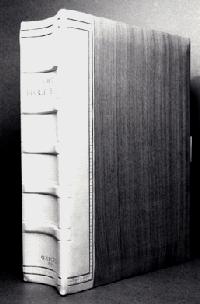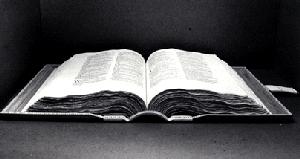
Volume 3 - Spring 1997
Letters & Feedback
Thank You
Thank you for the Autumn issue of Skin Deep. I have already bound a book of magazines using the Rigid Concave Spine Method as shown by James Brockman in this issue - it proved to be a great success.
The following trick may be of use to other amateur bookbinders like myself. When rubbing down end papers, instead of using ordinary paper, try using the silicone release paper from 'Fablon' or other such product or even a cornflake packet using the shiny side uppermost. The bone folder will glide like magic with little or no drag - superb!!!
With many thanks to your excellent staff and your very good delivery service,
yours faithfully,
A.W. Martin, Lowestoft
Concave Spines
My initial reaction when reading James Brockman's article on The Rigid Concave Spine was "lucky fellow having that much time to spend experimenting, some of us have got busy workshops to run you know".
My next reaction was one of interest and I am now full of questions such as:
-
Does the grain or
weight of paper affect the work?
What sort of glue
is used?
Why sew on tapes?
Is the thickness of
the volume a deciding factor in the suitability of a concave spine?
Can concave spines
really be called fine bindings?
I am not convinced
that there will be less strain on the sewing and in my opinion the book
may have more tendency to move than with a conventional style of binding.
Who knows, maybe one day I will have time to discover for myself, but in
the meantime it is interesting to hear other binders ideas. Thank you James.
James Brockman replies:
I am grateful to Mr. Brignell for taking the time to respond to my article "The Rigid Concave Spine" in your newsletter, Skin Deep Number 2. I was hoping for some reaction from fellow binders and hoped that a discussion in your columns would follow.
I, too, run a busy workshop employing several people with the pressures of maintaining quality, meeting deadlines etc. but I have always found time to experiment and develop new ideas along side my everyday work. This approach has worked well for over 20 years and I can remember in 1975-6 there were months of evenings and weekends designing and making my first electronic binding. This was a purely speculative exercise and in fact the binding was brought by the first collector who saw it for £2000!
I have maintained this approach to binding and question every technique and style I come across. No binder in the past had all the answer and no binder today has all the answers but I believe we should pass on more that we inherit.
In response to Barry's particular points:
I do not believe
the grain or weight of paper would present any additional problems over
the rounded and backed book.
I always use a thin
layer of edible gelatine on the back of the sections for good reversibility.
After the initial linings unbleached Irish linen and acid-free paper -
PVA may be used.
I prefer to sew on
tapes as this cuts down on the bulk over the joints and makes lining and
spine easier (8 or more linings are needed). I have bound one rigid concave
spine binding sewn on single raised cords. The boards were attached by
flattening the slips and gluing into the split boards.
To date, the thinnest
book I have bound using this method was 1/2" miniature book and the thickest
5" Bruce Rogers, Oxford Lectern Bible (See photographs).
I did not invent
the Rigid Concave Spine with a view to using it on fine bindings. In fact
it evolved from my interest in binding structure whilst rebinding manuscripts,
early printed books etc. and I have always considered the structure most
suitable for conservation binding. However, my earlier invention of the
single hinge binding produced a concave spine automatically, therefore
if the techniques, materials and structure are fine, then I see no reason
why it cannot be used on a fine binding.
With regard to strain on the sewing, I would emphasise that it is a Rigid Concave Spine. There must be enough spine linings to guarantee that the spine will not move - WHAT DOES NOT MOVE DOES NOT BREAK!

Quarter
sawn oak boards with
alum-tawed leather spine, gold and blind tooling
Open Book

